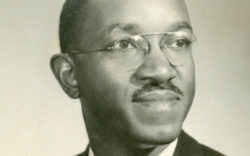Where the ol’ Bloviator’s opinions are concerned, the problem has never been supply, but demand. Since the tragic shooting in Charleston on June 17 and the ensuing moves against the Confederate battle flag as public symbol, the OB and other hoary denizens laboring in the normally tangled obscurity of the southernological jungle, have been engulfed in a gnat-like swarm of exceedingly persistent media types. actually bent on soliciting their views, though intent primarily, it seems, either on simply appropriating them as their own or distorting them so grotesquely as to make the kindly, unsuspecting prof seem like a complete ninny. Realizing that he could accomplish the latter just fine on his own, a weary OB finally gave voice to his own thoughts in an outcry actually heard and passed on by a few semi-respectable outlets. What follows is an expanded and updated version of his cri de coeur.
The most striking aspect of the Bamberg, SC grade school class photo (ca. 1980) is not the nine black youngsters scattered among the 23 white pupils. Bamberg schools had been integrated under a court order roughly a decade earlier. Rather, the real eye-catcher in the shot is the little girl with the flowing black hair and skin only slightly lighter than that of some of her African American classmates.
A few years earlier, this little girl and her sister had also stood out among the contestants at the annual Miss Wee Bamberg Pageant where, in the wake of school desegregation, it had become the practice to crown both a white and a black winner. Though she seemed irresistibly huggable in her ruffled dress and black patent shoes, there would be no crown for contestant No. 40, for she and her sister had introduced an unforeseen and unwanted element of racial ambiguity that left pageant officials fearful that neither the white nor black parents in the audience would accept the two little brown-skinned daughters of an immigrant Sikh couple in their racial category.
South Carolina Gov. Nikki Haley.
What may well prove to be the most striking of all the many ironies in the life and career of Nikki Haley, born Nimrata Nikki Randhawa, came when, at her mother’s request, she was at least allowed to perform her talent number, a very capable rendition of “This Land Is Your Land.”
Anyone searching for a compelling visual testimony to the brutal absurdity of the American South’s racial obsessions surely need look no further than the photo of little Nikki, still standing there after the pageant, uncertainly clutching the wrapped package containing the fittingly deflated beach ball that she and her sister received as consolation prizes for their disqualification. Surely, no one in attendance that night, save, one senses in retrospect, perhaps the little girl herself, had any idea that some 35 years later, a not-exactly-thriving Bamberg (Population: 3,600. Major Points of Interest: a Hardee’s fast food restaurant and a Dollar General Store) would boast four signs welcoming motorists to the “Home of Nikki Haley, Governor of South Carolina.”
It is tempting to see a story of both personal triumph and regional redemption in the meteoric political ascent of this woman, who was born an “other” to blacks and whites in a society where skin color really mattered. Yet, contrary to deep-seated liberal presumptions, Nikki Haley has proven to be anything but the empathetic, compassionate champion of minorities and women that her background seemed almost to mandate.
Instead, if anything, for a savvy young woman like Haley, growing up almost astride the color line may have encouraged a rather precocious decision on which side of the racial divide offered the better prospects for fulfilling her ambitions.
The same was true of the partisan divide as well, for South Carolina was already an established GOP stronghold when she entered the 2004 primary, where she stunned the pundits by knocking off the longest-serving incumbent in the state House of Representatives before sailing unopposed in an overwhelmingly Republican district through the general election to take her seat as the first Indian-American member of the South Carolina legislature.
Haley’s success in this contest was surprising, but it paled in comparison to her victorious shoestring gubernatorial campaign, which ultimately dispatched three better known and better funded primary rivals and opened the door to the governor’s mansion for its first-ever female and non-white occupant.
Haley’s gender had earned her no gentlemanly deference during a campaign marked by persistent rumors of her marital infidelity and a fellow Republican politico’s reference to her as a “f**king raghead.” This public display of bigotry was a bit over the top even in South Carolina, and it doubtless helped Haley more than it hurt her, as state and national Republican leaders rallied to her defense, including Sarah Palin, who praised her as “the proud daughter of immigrants who worked day and night to achieve the American dream.”
Such an endorsement might seem a tad hypocritical coming from someone who has hardly distinguished herself as a friend of immigrants or people of color in general, but then, truth be told, neither has Nikki Haley, an early tea party favorite whose votes and positions as a legislator and governor amount to a checklist of Palin’s favorite things.
For example, Haley is an ardent opponent of abortion rights, gun control, higher taxes on high incomes and a pathway to citizenship for illegal immigrants. As governor, she championed a new law requiring state-issued photo IDs for all voters, and despite her state’s large indigent population, she refused the Obamacare plan’s offer of increased Medicaid funding, flatly declaring, “We will not expand Medicaid, ever.”
On the other hand, Haley is just fine with forking over lavish public subsidies to new employers who also have the governor’s personal assurance that “we’d rather die than have unions here.”
Truth be told, Haley’s stance on any of the foregoing issues is hardly unique among today’s Deep South governors, and her unwavering faith in getting new industry at any cost has long been nothing less than gubernatorial gospel in the region.
Forced increasingly to weigh their obligations to preserve segregation against the development imperative, the balance began to tip in favor of the latter in the 1960s, when concerns about the potentially harmful effects of racial violence and defiance on industrial recruitment helped to pave the way for the initial desegregation of public schools and other public facilities and accommodations. A similar consideration has factored heavily into more recent disputes over removing the Confederate battle flag from state property or excising it from the flags of several Southern states.
In South Carolina, that flag might still be flying atop the state Capitol had a torrent of threatened economic and tourist boycotts and pressure from the state’s business community not forced the legislature 15 years ago to at least move it to the capitol grounds. Though this placement was still far from satisfactory to most black South Carolinians, Governor Haley had shown no public inclination to move against it until the cold-blooded slaughter of nine African Americans inside their Charleston church by a Rebel-flag-worshipping gunman became both catalyst and premise for a step that Southern white political officials had been at once eager but too timid to take.
The flag issue has long been the proverbial elephant not simply in the room but squarely astride the shoulders of Southern GOP governors and congressmen, not to mention business and development leaders. Not only did it pose a threat to party unity, but clinging to such a divisive and seemingly hostile and provincial symbol is hardly indicative of a state or community ready to host a major production facility of an international and even global corporation.
Make no mistake about it: The moves by Nikki Haley and her counterparts in other Southern states amounted in no small sense to what a proponent of ditching the Confederate insignia on the Mississippi state flag once called a “strategic business decision.” Without questioning the sincerity of their expressions of horror and grief over the Charleston tragedy in the least, distancing their state and their party from what so many see as an emblem of hatred and persecution seems to have a huge upside for Southern and national Republicans, especially those with presidential (or perhaps, vice-presidential) ambitions like South Carolina’s Senator Lindsey Graham or perhaps even its governor as well.
One thing is certain, with the flag now furled and consigned to a museum, Governor Haley’s brilliant, genuinely impassioned leadership over the last three weeks truly dwarfs anything Sarah Palin accomplished as governor of Alaska.
Newsweek’s decision in July 2010 to herald Nikki Haley on its cover as “The Face of the New South” may have startled some at the time, but this has become a common trope in recent days. Its aptness, however, rests not in Haley’s skin color or gender but in her politics. Lest we get a tad carried away here, let’s note that, over the last generation or so, the GOP has gradually abandoned its old blatantly racialized “Southern strategy” in favor of a new, ostensibly “colorblind” but hardly race-neutral conservatism anchored in the rigidly anti-tax, anti-welfare, anti-labor but pro-gun, pro-voter suppression and indisputably ardent pro-corporate attitudes that essentially define Governor Haley’s mindset.
For Haley and her cohort, that mindset is unlikely to change anytime soon, regardless of what flag flies where. All of that said, however, regardless of whether her motives were at least partially political or not, Haley has done the right thing. History is hardly so flush with examples of right things done for precisely the right reasons to afford us the luxury of being picky.
Like what you just read? Support Flagpole by making a donation today. Every dollar you give helps fund our ongoing mission to provide Athens with quality, independent journalism.









